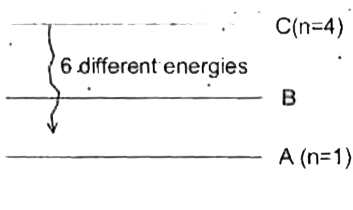In a sample of hydrogen atoms, all the atoms exist in two energy levels A and B. A is the ground level and B is some higher energy level. These atoms absorb photons of energy 2.7 eV and attain a higher energy level C.After this, these atoms emit photons of six different energies. Some of these photon energies are higher than 2.7 eV, some equal to 2.7 eV and some are loss than 2.7 eV.
The principal quantum number corresponding to energy level B is
Level C must correspond to n=4 since the total number of possible transitions from level 4 to lower levels is 1+2+3+4 =6.The level corresponds either to n=2or n=3.The energies of all the photons involved in the transitions are (in eV):,,,,,.The only possible choices are (a) Z=1 and (b) Z=2 ,.The choice Z=2 however is consistent with the fact that some products have energy less than 2.7 eV.(i) Thus, Z=1 and the quantum number of level B is n=2.The ionisation energy is ,.(iii) The maximum energy of the photons is 0.66eV(E_(4),_(3)).

Similar Questions
In a sample of hydrogen atoms, all the atoms exist in two energy levels A and B. A is the ground level and B is some higher energy level. These atoms absorb photons of energy 2.7 eV and attain a higher energy level C.After this, these atoms emit photons of six different energies. Some of these photon energies are higher than 2.7 eV, some equal to 2.7 eV and some are loss than 2.7 eV.
The atomic number of these atoms is
View SolutionIn a sample of hydrogen atoms, all the atoms exist in two energy levels A and B. A is the ground level and B is some higher energy level. These atoms absorb photons of energy 2.7 eV and attain a higher energy level C.After this, these atoms emit photons of six different energies. Some of these photon energies are higher than 2.7 eV, some equal to 2.7 eV and some are loss than 2.7 eV.
The longest wavelength emitted in the radiation spectrum observed is
View SolutionA gas of identical hydrogen-like atoms has some atoms in the lowest in lower (ground) energy level A and some atoms in a partical upper (excited) energy level B and there are no atoms in any other energy level.The atoms of the gas make transition to higher energy level by absorbing monochromatic light of photon energy 2.7eV.
Subsequenty , the atom emit radiation of only six different photon energies. Some of the emitted photons have energy 2.7eV some have energy more , and some have less than 2.7eV.
a Find the principal quantum number of the intially excited level B
b Find the ionization energy for the gas atoms.
c Find the maximum and the minimum energies of the emitted photons.
View SolutionAn isolated hydrogen atom emits a photon of energy 9 eV. Find momentum of the photons
View SolutionAn isolated hydrogen atom emits a photon of energy 9 eV. Find momentum of the photons
View SolutionThe approximate wavelength of a photon of energy 2.48eV is
View SolutionIn Bohr's model of hydrogen atom, let PE represents potential energy and TE the total energy. In going to a higher level
View SolutionIn hydrogen atom, the order of energies of sub-shell of third energy level is ……….
View SolutionFor hydrogen atom, energy of nth level is given by
View SolutionWhen an electron of hydrogen like atom jumps from a higher energy level to a lower energy level.
View Solution
